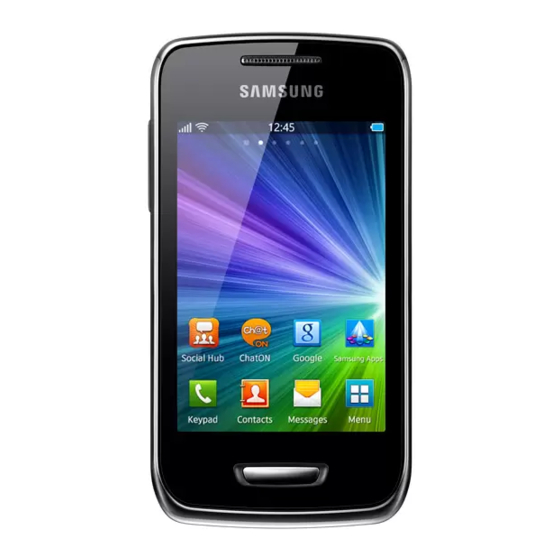Samsung Wave Y GT-S5380D Руководство пользователя - Страница 15
Просмотреть онлайн или скачать pdf Руководство пользователя для Сотовый телефон Samsung Wave Y GT-S5380D. Samsung Wave Y GT-S5380D 37 страниц.

Persons with pacemakers:
should always keep the phone more than 15 cm
(6 inches) from their pacemaker when the phone is switched on.
should not carry the phone in a breast pocket.
should use the ear opposite the pacemaker to minimize potential
interference.
If you have any reason to suspect that interference is taking place, switch
your phone off immediately.
Hearing Aids
Some digital wireless phones may interfere with some hearing aids. In the
event of such interference, you may wish to consult your hearing aid
manufacturer to discuss alternatives.
Other Medical Devices
If you use any other personal medical devices, consult the manufacturer
of your device to determine if it is adequately shielded from external RF
energy. Your physician may be able to assist you in obtaining this
information. Switch your phone off in health care facilities when any
regulations posted in these areas instruct you to do so. Hospitals or
health care facilities may be using equipment that could be sensitive to
external RF energy.
Vehicles
RF signals may affect improperly installed or inadequately shielded
electronic systems in motor vehicles. Check with the manufacturer or its
representative regarding your vehicle. You should also consult the
manufacturer of any equipment that has been added to your vehicle.
Posted Facilities
Switch your phone off in any facility where posted notices require you to
do so.
Potentially Explosive Environments
Switch your phone off when in any area with a potentially explosive
atmosphere and obey all signs and instructions. Sparks in such areas
could cause an explosion or fire resulting in bodily injury or even death.
Users are advised to switch the phone off while at a refueling point
(service station). Users are reminded of the need to observe restrictions
on the use of radio equipment in fuel depots (fuel storage and distribution
areas), chemical plants or where blasting operations are in progress.
Areas with a potentially explosive atmosphere are often but not always
clearly marked. They include below deck on boats, chemical transfer or
storage facilities, vehicles using liquefied petroleum gas (such as propane
or butane), areas where the air contains chemicals or particles, such as
grain, dust or metal powders, and any other area where you would
normally be advised to turn off your vehicle engine.
Emergency Calls
